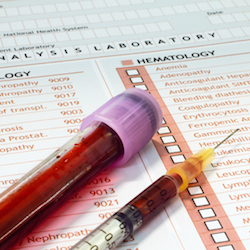By now you’ve heard that niacin is no longer recommended for reducing heart attacks and strokes. After 50 years of being a mainstay cholesterol therapy, niacin should no longer be prescribed for most patients due to potential increased risk of death, dangerous side effects and no benefit in reducing heart attacks and strokes, writes Northwestern Medicine® preventive cardiologist Donald Lloyd-Jones, M.D., in a New England Journal of Medicine editorial published July 16.
Lloyd-Jones’s editorial is based on a large study published in the journal, which is a follow-on to the HPS2-THRIVE Collaborative Group trial from 2013. This round of study looked at adults, ages 50 to 80, with cardiovascular disease who took extended-release niacin (vitamin B3) and laropiprant (a drug that reduces face flushing caused by high doses of niacin) to see if it reduced heart attack and stroke compared to a placebo over four years. All patients in the trial were already being treated with a statin medication.
Niacin did not reduce heart attacks and stroke rates compared with a placebo. The study shows niacin was associated with an increased trend toward death from all causes as well as increases in liver problems, excess infections, excess bleeding, gout, loss of control of blood sugar for diabetics and the development of diabetes in people who didn’t have it when the study began.
The study makes three recommendations:
- Niacin does not reduce heart attacks or strokes
- Niacin linked to increase in death risk, excess bleeding and diabetes
- Statins remain best choice to reduce heart attack and stroke risk
The study is no doubt controversial among integrative care practitioners, especially when one considers commonly known adverse events  associated with statins, such as blood sugar control (the slideshow above sections out the findings). In the New England J study, niacin–laropiprant was associated with an increased incidence of disturbances in diabetes control that were considered to be serious (absolute excess as compared with placebo, 3.7 percentage points; P<0.001) and with an increased incidence of diabetes diagnoses (absolute excess, 1.3 percentage points; P<0.001).
associated with statins, such as blood sugar control (the slideshow above sections out the findings). In the New England J study, niacin–laropiprant was associated with an increased incidence of disturbances in diabetes control that were considered to be serious (absolute excess as compared with placebo, 3.7 percentage points; P<0.001) and with an increased incidence of diabetes diagnoses (absolute excess, 1.3 percentage points; P<0.001).
It is not clear whether the niacin-related diabetes risk was greater that that posed by statins alone. In 2013, statins were associated with a 9% increased risk of diabetes compared with patients treated with placebo (odds ratio 1.09; 1.02–1.16), according to a meta-analysis in Circulation: Cardiovascular Quality and Outcomes.
“There might be one excess death for every 200 people we put on niacin,” said Lloyd-Jones, chair of preventive medicine at Northwestern University Feinberg School of Medicine and Northwestern Memorial Hospital. “With that kind of signal, this is an unacceptable therapy for the vast majority of patients.”“For the reduction of heart disease and stroke risk, statins remain the most important drug-based strategy by far because of their demonstrated benefit and their good safety profile,” said Lloyd-Jones, who was a member of the task force that rewrote cholesterol treatment guidelines in 2013 for the American College of Cardiology and the American Heart Association.
Niacin should be reserved only for patients at very high risk for a heart attack and stroke who can’t take statins and for whom there are no other evidence-based options, Lloyd-Jones said.
 Niacin raises “good” HDL (high density lipoprotein) cholesterol levels, and having high HDL levels means a lowered risk for cardiovascular events. But clinical trials have not shown that niacin reduced the risk of coronary heart disease or the broader cardiovascular disease specifically by raising HDL. Niacin also produces a modest reduction in low-density lipoprotein (LDL cholesterol) and a more substantial reduction in triglyceride levels, which might be expected to lower the risk of coronary heart disease, Lloyd-Jones notes in the article.
Niacin raises “good” HDL (high density lipoprotein) cholesterol levels, and having high HDL levels means a lowered risk for cardiovascular events. But clinical trials have not shown that niacin reduced the risk of coronary heart disease or the broader cardiovascular disease specifically by raising HDL. Niacin also produces a modest reduction in low-density lipoprotein (LDL cholesterol) and a more substantial reduction in triglyceride levels, which might be expected to lower the risk of coronary heart disease, Lloyd-Jones notes in the article.
But the new study suggests that higher HDL levels only are a sign of lowered risk for heart attacks and stroke. Raising HDL levels with niacin does not appear to impact cardiovascular outcomes nor does lowering triglyceride levels, Lloyd-Jones points out.
“The recent niacin clinical trials offer important new evidence that raising ‘good’ cholesterol (HDL) levels on top of statin therapy does not have the positive outcome that had been hoped for,” said Neil Stone, M.D., the Robert Bonow MD Professor in Cardiology at Feinberg and a cardiologist at Northwestern Memorial Hospital. “Lowering ‘bad’ cholesterol (LDL) with an optimal intensity of tolerated statins and adherence to healthy lifestyle changes remains the most effective approach to prevent strokes and heart attacks for patients at risk of cardiovascular disease.”
Stone was chair of the expert panel that wrote rewrote cholesterol treatment guidelines in 2013 for the American College of Cardiology and the American Heart Association.
NEJM Editorial Advises Against Extended-Release Niacin
By now you’ve heard that niacin is no longer recommended for reducing heart attacks and strokes. After 50 years of being a mainstay cholesterol therapy, niacin should no longer be prescribed for most patients due to potential increased risk of death, dangerous side effects and no benefit in reducing heart attacks and strokes, writes Northwestern Medicine® preventive cardiologist Donald Lloyd-Jones, M.D., in a New England Journal of Medicine editorial published July 16.
Lloyd-Jones’s editorial is based on a large study published in the journal, which is a follow-on to the HPS2-THRIVE Collaborative Group trial from 2013. This round of study looked at adults, ages 50 to 80, with cardiovascular disease who took extended-release niacin (vitamin B3) and laropiprant (a drug that reduces face flushing caused by high doses of niacin) to see if it reduced heart attack and stroke compared to a placebo over four years. All patients in the trial were already being treated with a statin medication.
Niacin did not reduce heart attacks and stroke rates compared with a placebo. The study shows niacin was associated with an increased trend toward death from all causes as well as increases in liver problems, excess infections, excess bleeding, gout, loss of control of blood sugar for diabetics and the development of diabetes in people who didn’t have it when the study began.
The study makes three recommendations:
The study is no doubt controversial among integrative care practitioners, especially when one considers commonly known adverse events associated with statins, such as blood sugar control (the slideshow above sections out the findings). In the New England J study, niacin–laropiprant was associated with an increased incidence of disturbances in diabetes control that were considered to be serious (absolute excess as compared with placebo, 3.7 percentage points; P<0.001) and with an increased incidence of diabetes diagnoses (absolute excess, 1.3 percentage points; P<0.001).
associated with statins, such as blood sugar control (the slideshow above sections out the findings). In the New England J study, niacin–laropiprant was associated with an increased incidence of disturbances in diabetes control that were considered to be serious (absolute excess as compared with placebo, 3.7 percentage points; P<0.001) and with an increased incidence of diabetes diagnoses (absolute excess, 1.3 percentage points; P<0.001).
It is not clear whether the niacin-related diabetes risk was greater that that posed by statins alone. In 2013, statins were associated with a 9% increased risk of diabetes compared with patients treated with placebo (odds ratio 1.09; 1.02–1.16), according to a meta-analysis in Circulation: Cardiovascular Quality and Outcomes.
“There might be one excess death for every 200 people we put on niacin,” said Lloyd-Jones, chair of preventive medicine at Northwestern University Feinberg School of Medicine and Northwestern Memorial Hospital. “With that kind of signal, this is an unacceptable therapy for the vast majority of patients.”“For the reduction of heart disease and stroke risk, statins remain the most important drug-based strategy by far because of their demonstrated benefit and their good safety profile,” said Lloyd-Jones, who was a member of the task force that rewrote cholesterol treatment guidelines in 2013 for the American College of Cardiology and the American Heart Association.
Niacin should be reserved only for patients at very high risk for a heart attack and stroke who can’t take statins and for whom there are no other evidence-based options, Lloyd-Jones said.
But the new study suggests that higher HDL levels only are a sign of lowered risk for heart attacks and stroke. Raising HDL levels with niacin does not appear to impact cardiovascular outcomes nor does lowering triglyceride levels, Lloyd-Jones points out.
“The recent niacin clinical trials offer important new evidence that raising ‘good’ cholesterol (HDL) levels on top of statin therapy does not have the positive outcome that had been hoped for,” said Neil Stone, M.D., the Robert Bonow MD Professor in Cardiology at Feinberg and a cardiologist at Northwestern Memorial Hospital. “Lowering ‘bad’ cholesterol (LDL) with an optimal intensity of tolerated statins and adherence to healthy lifestyle changes remains the most effective approach to prevent strokes and heart attacks for patients at risk of cardiovascular disease.”
Stone was chair of the expert panel that wrote rewrote cholesterol treatment guidelines in 2013 for the American College of Cardiology and the American Heart Association.
Related Articles
A Robust Multi and Proper Immune Support Are a Home Run for Cold/Flu Season
Read MoreThe Perfect Diet
Read MoreAHCC and Immunity: Evidence-Based Insights into Comprehensive Immune Support
Read More